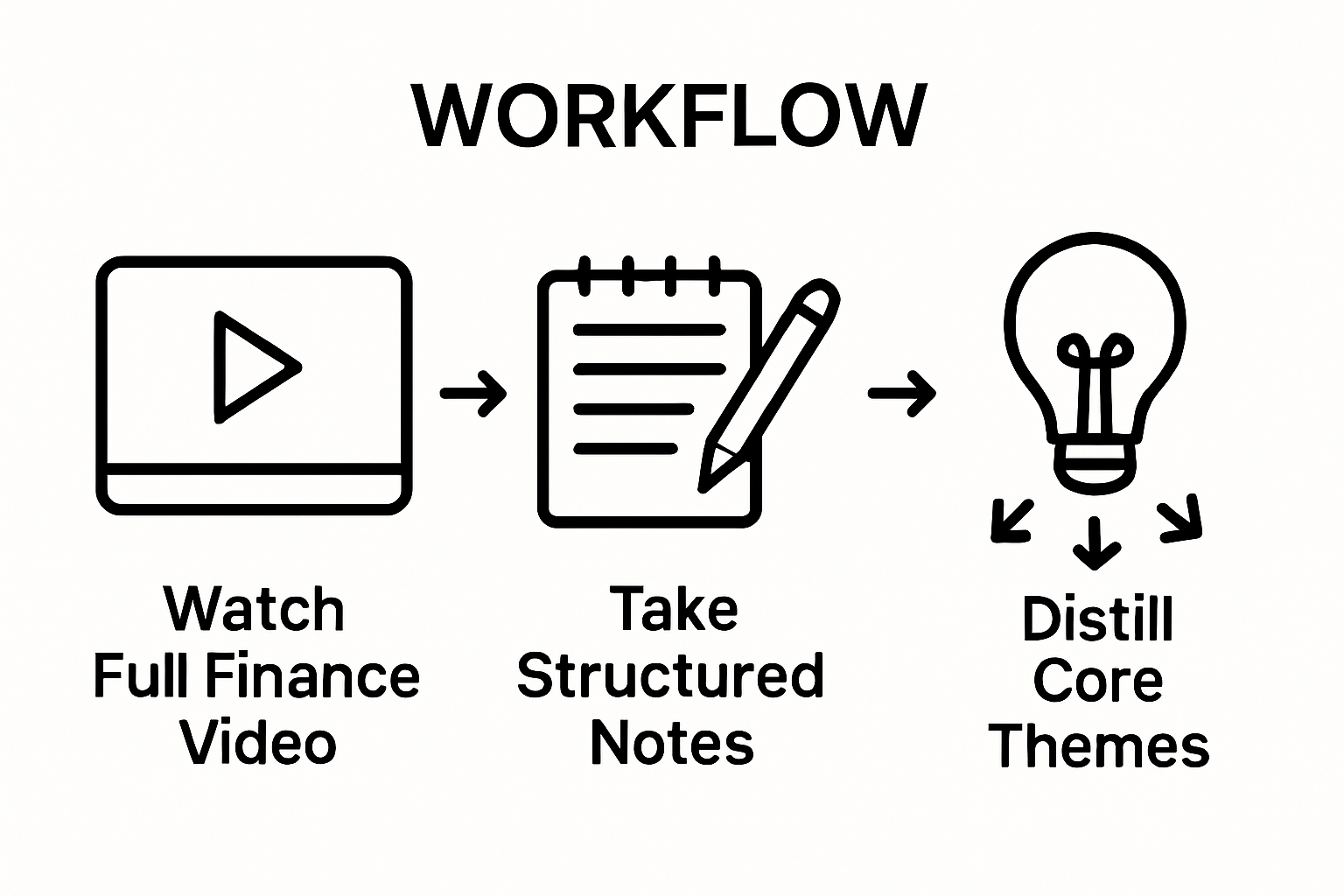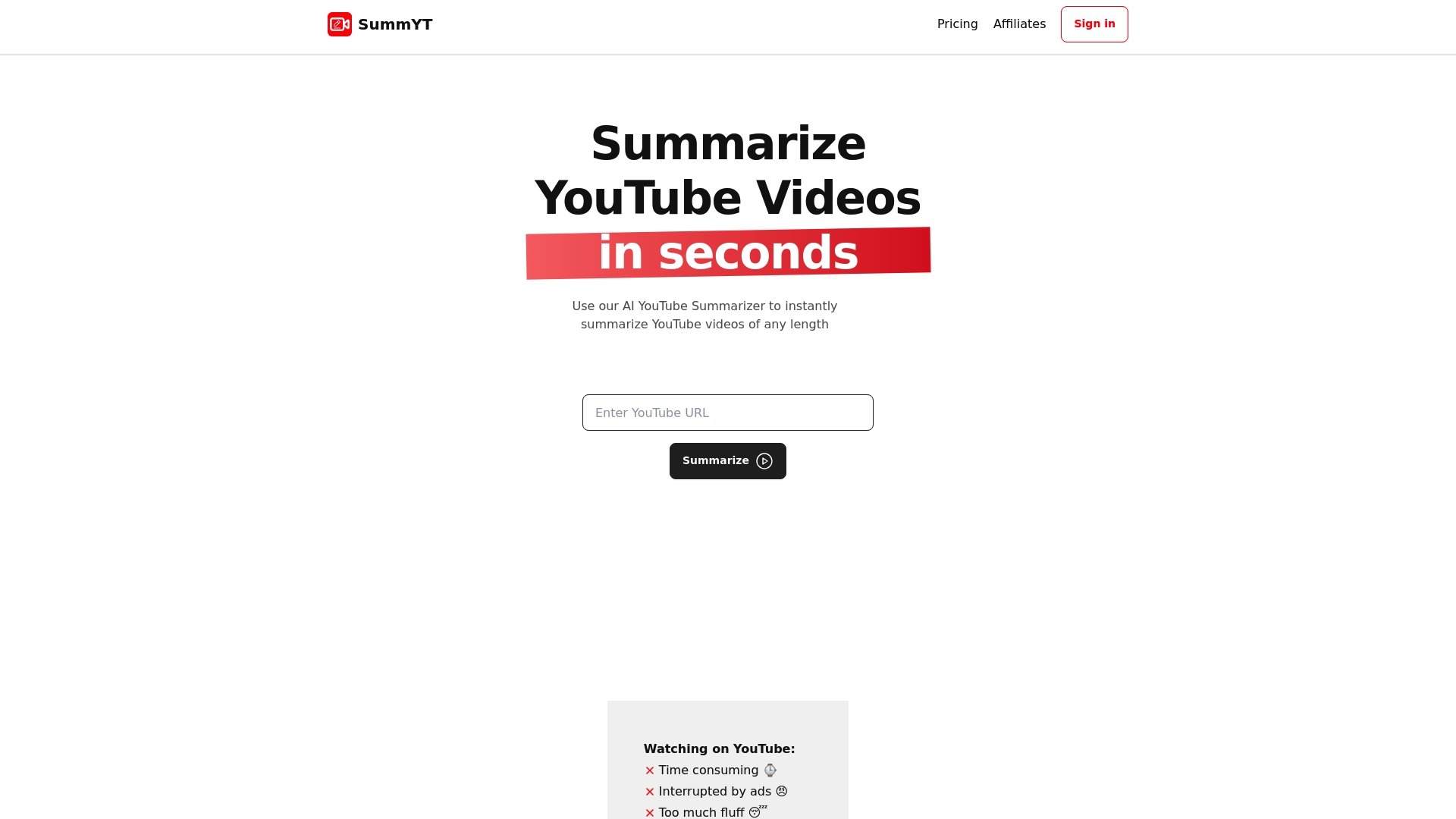How to Summarize Finance Videos Quickly and Effectively

Summarizing finance videos sounds overwhelming when each one can pack in more than eight complex financial concepts every three minutes. Most people assume you need advanced training or hours of effort just to make sense of it all. The truth is you only need the right method and a sharp focus to break these videos down into clear, useful scripts anyone can use.
Table of Contents
- Step 1: Identify Key Concepts And Themes
- Step 2: Take Structured Notes During Viewing
- Step 3: Create A Concise Script From Notes
- Step 4: Edit For Clarity And Brevity
- Step 5: Review And Finalize Your Summary
Quick Summary
| Key Point | Explanation |
|---|---|
| 1. Watch the video fully first | Gain a complete understanding of the presenter’s message and main ideas before noting details. |
| 2. Use structured note-taking methods | Organize notes with predefined sections to efficiently capture essential financial insights during video viewing. |
| 3. Create a concise summary script | Distill notes into a clear narrative that reflects the core message and important financial concepts of the video. |
| 4. Edit for clarity and brevity | Focus on sharpening language and removing redundancy to ensure essential ideas drive the summary effectively. |
| 5. Final review for accuracy | Verify that all key concepts are represented clearly and that the summary remains professional and valuable for readers. |
Step 1: Identify Key Concepts and Themes
Summarizing finance videos effectively starts with a strategic approach to extracting core themes and critical information. This initial step is about transforming complex financial content into digestible insights that capture the essence of the video’s message. By systematically breaking down the video’s core narrative, you create a foundation for a comprehensive yet concise summary.
Begin by watching the entire finance video without interruption, focusing on the presenter’s primary arguments, key data points, and overarching financial principles. Take mental notes of recurring themes, significant statistics, and unique perspectives shared. During this initial viewing, avoid the temptation to pause or take detailed notes. Instead, aim to understand the video’s fundamental structure and primary message.
After the initial viewing, rewatch the video with a more analytical lens. Pause strategically at moments that reveal critical insights. Look for sections where the presenter introduces significant financial concepts, provides statistical evidence, or shares expert analysis. Pay special attention to visual aids like charts, graphs, and comparative data that illustrate complex financial principles. These visual elements often distill complicated information into easily understandable formats.
Document your observations systematically. Create a structured framework that categorizes information into main themes, supporting arguments, and key takeaways. Some finance videos might focus on investment strategies, while others might explore economic trends or market analysis. Your goal is to create a clear, organized outline that reflects the video’s core narrative.
For complex finance videos, consider using specific tools for video summarization that can help track and categorize important segments. These tools can assist in identifying and marking significant moments, making your summarization process more precise and efficient.
Verify your theme identification by asking critical questions: Have I captured the presenter’s main argument? Do my identified themes represent the video’s core message? Can someone understand the essential information without watching the entire video? If you can confidently answer these questions, you have successfully completed the first step in summarizing your finance video.

Step 2: Take Structured Notes During Viewing
Taking structured notes during a finance video is a critical skill that transforms passive watching into active learning. This step requires concentration, strategic thinking, and a systematic approach to capturing essential information efficiently. Your goal is to create a clear, concise record that reflects the video’s most important financial insights and complex concepts.
Prepare your note-taking environment before starting the video. Choose a digital tool or physical notebook that allows quick, organized documentation. Digital tools like Notion, Evernote, or OneNote offer template flexibility and easy organization. For finance videos, create a template with predefined sections: key concepts, statistical data, expert quotes, investment strategies, and personal observations. This structured approach prevents overwhelming note-taking and ensures you capture targeted information.
During the video, adopt a selective yet comprehensive note-taking strategy. Focus on capturing precise financial details rather than transcribing every word. Listen for numerical data, percentages, financial ratios, and comparative statements that provide substantive insights. Mark timestamps for critical segments you might want to revisit later. This allows you to quickly reference specific moments without rewatching the entire video.
Learn advanced techniques for video note-taking that can help streamline your process. Develop a personal shorthand or symbol system that accelerates your note-taking speed. For instance, use “↑” for increasing trends, “↓” for declining trends, and “*” for critical insights. These symbols help you quickly differentiate between general information and pivotal financial moments.
Remember that effective note-taking is about quality, not quantity. Financial videos often contain dense information, so prioritize understanding over exhaustive documentation. After completing your notes, take a moment to review and refine them. Eliminate redundant information, clarify unclear points, and ensure your notes tell a coherent story about the video’s core financial message.
Verify the effectiveness of your notes by asking: Can someone unfamiliar with the video understand its key points from my notes? Do my notes capture the primary financial concepts, arguments, and insights? If you can confidently answer yes, you have successfully completed the structured note-taking process.

Step 3: Create a Concise Script from Notes
Transforming your detailed notes into a concise, clear script is where the true art of video summarization becomes apparent. This step requires precision, strategic thinking, and the ability to distill complex financial information into its most essential elements. Your goal is to create a summary that captures the video’s core message without losing critical nuances.
Begin by organizing your raw notes into a logical narrative structure. Start with a strong opening that encapsulates the video’s primary financial concept or argument. Group related ideas together, creating a flow that mirrors the original video’s progression. Focus on maintaining the logical sequence of ideas while ruthlessly eliminating redundant or tangential information. Finance videos often contain technical details, so prioritize clarity and comprehension over including every single data point.
Draft your script using clear, direct language that speaks to financial professionals and learners alike. Aim for sentences that are crisp and informative, typically ranging between 15 to 20 words. Use active voice to make your summary more engaging and direct. For instance, instead of writing “Investment strategies were discussed by the presenter,” write “The presenter outlined three key investment strategies.” This approach makes your script more dynamic and easier to comprehend.
Explore advanced techniques for creating video summaries that can help refine your scripting process. Pay special attention to numerical data, financial trends, and expert insights. Include precise percentages, comparative statistics, and significant financial observations. However, present these details contextually, explaining their broader implications rather than listing them mechanically.
Consider the perspective of someone who has not watched the original video. Your script should provide a comprehensive understanding of the content without requiring additional background knowledge.
Use transitional phrases to connect different sections smoothly, creating a narrative that flows logically from one point to the next. Highlight the most impactful moments from the video, whether they are groundbreaking financial insights, unexpected market trends, or critical expert recommendations.
Verify the effectiveness of your script by asking critical questions: Does this summary capture the video’s core message? Can someone unfamiliar with the original video understand its key financial concepts? Is the language clear, concise, and engaging? If you can confidently answer yes to these questions, you have successfully transformed your notes into a powerful, informative script that distills complex financial content into an accessible narrative.
Step 4: Edit for Clarity and Brevity
Editing your finance video summary requires a surgical approach to distilling information while preserving its essential meaning. This critical step transforms your initial draft into a polished, professional script that communicates complex financial concepts with maximum impact and minimal wordiness. Your editing process will focus on eliminating redundancy, sharpening language, and ensuring every sentence delivers genuine value.
Read your initial draft multiple times, each pass with a different editing objective. First, focus on overall structure and logical flow. Ensure your summary follows a clear narrative arc that mirrors the original video’s progression. Identify sections that feel cluttered or overly technical. Finance content often contains complex terminology, so your goal is to translate these concepts into language that is both precise and accessible. Ruthlessly remove unnecessary words, breaking down complex sentences into clear, direct statements. Replace passive constructions with active voice, which makes your writing more engaging and easier to understand.
Discover advanced techniques for video content condensation that can help streamline your summarization process. Pay special attention to financial jargon and technical terms. While these are important, they should be explained concisely. If a technical term requires extensive explanation, consider whether it truly adds value to your summary or can be simplified without losing critical meaning.
Consider the perspective of your target audience. A summary for financial professionals will differ from one aimed at general learners. Use industry-specific language judiciously, ensuring that your explanations remain clear and comprehensible. Break down complex financial concepts into digestible pieces, using analogies or real-world examples when appropriate. This approach helps make abstract financial ideas more concrete and relatable.
Verify the effectiveness of your edited summary by applying a strict set of criteria. Ask yourself these critical questions: Does each sentence serve a clear purpose? Have I eliminated all redundant information? Is the language precise yet accessible? Can someone unfamiliar with the original video understand its key financial insights? Would a busy professional find this summary valuable and time-efficient? If you can confidently answer yes to these questions, you have successfully transformed your initial draft into a concise, powerful summary that captures the essence of the original finance video.
Step 5: Review and Finalize Your Summary
Reviewing and finalizing your finance video summary represents the critical moment where raw content transforms into a polished, professional document. This final step ensures that your summary not only captures the video’s essential insights but also maintains a high standard of clarity, accuracy, and professional presentation. Think of this stage as the final polish that elevates your work from good to exceptional.
Create a systematic review process that goes beyond simple proofreading. Begin by reading your summary aloud, which helps identify awkward phrasing, overly complex sentences, and areas that might confuse readers. Listen for the natural flow of information and ensure that financial concepts are explained with precision and clarity. Pay special attention to numerical data, ensuring that percentages, financial ratios, and statistical information are accurately represented and contextualized.
Learn advanced techniques for creating refined video summaries that can help elevate your final product. Cross-reference your summary with your original notes and the video to verify absolute accuracy. Financial content demands extreme precision, so even minor errors can significantly impact the summary’s credibility. Check that technical terms are correctly used, financial concepts are accurately explained, and the overall narrative maintains the original video’s intent and message.
Consider having a peer or colleague with financial expertise review your summary. An external perspective can reveal blind spots in your explanation, highlight areas that need further clarification, or confirm the summary’s effectiveness. If a professional review isn’t possible, read the summary from the perspective of someone unfamiliar with the specific financial topic. Can they understand the key concepts? Does the summary provide meaningful insights without overwhelming technical details?
Verify the effectiveness of your final summary by applying a comprehensive checklist. Confirm that your summary meets these critical criteria: Is the language clear and professional? Have you accurately represented all key financial concepts? Does the summary provide meaningful insights in a concise format? Would a busy financial professional find this summary valuable and time-efficient? Can someone unfamiliar with the original video understand its core message? If you can confidently answer yes to these questions, you have successfully created a high-quality, professional summary that effectively captures the essence of the original finance video.
Below is a checklist table to help you verify that your final finance video summary meets all essential criteria for clarity, accuracy, and professional quality.
| Review Checklist Item | Description |
|---|---|
| Clear and professional language | Ensure the summary uses language that is easy to understand and professional in tone. |
| All key financial concepts represented | Check that every critical financial concept from the video is included accurately. |
| Meaningful insights provided concisely | Verify the summary delivers valuable insights in a brief, focused format. |
| Accurate use of technical terms | Confirm financial jargon and statistics are correct and appropriately explained. |
| Valuable for busy professionals | Assess if a professional could quickly gain essential takeaways from your summary. |
| Understandable without the video | Make sure someone unfamiliar with the original content can grasp the main ideas. |
Cut Hours Off Your Finance Video Summaries With AI
Feeling stuck spending too much time watching finance videos just to extract a few key insights? The article you just explored reveals how identifying main themes, structured note-taking, and editing for clarity are vital steps in building fast, accurate summaries. If your goal is to make sense of complex financial content without getting lost in the details, there is an easier, smarter way.

Stop letting valuable hours slip away in manual note-taking and endless rewinding. SummYT transforms this entire process with AI-powered summarization designed for students, professionals, and lifelong learners. SummYT quickly captures core themes, key statistics, and expert analysis from any YouTube finance video. It removes the fluff so you get what matters, faster.
Try SummYT today and experience how it can help you summarize webinars, lectures, and financial reports in minutes. Take control of your learning and productivity — sign up now and start saving time immediately.
Frequently Asked Questions
How can I effectively identify key concepts in a finance video?
To effectively identify key concepts in a finance video, watch the entire video first without interruptions to grasp the presenter’s main arguments and themes. During a second viewing, take strategic pauses to document critical insights, focusing on significant financial principles, statistics, and visual aids that help convey complex information.
What tools can I use for taking structured notes while watching finance videos?
You can use digital tools like Notion, Evernote, or OneNote to take structured notes. Create templates with sections for key concepts, statistics, expert quotes, and personal observations to help you organize information efficiently without getting overwhelmed.
How do I ensure my summary is concise yet informative?
To ensure your summary is concise and informative, start by organizing your notes into a logical structure and eliminate redundancy. Use clear and direct language, focusing on important financial concepts and significant details while keeping sentences between 15 to 20 words for better readability.
What final checks should I perform before finalizing my finance video summary?
Before finalizing your summary, read it aloud to check for awkward phrasing and clarity. Cross-reference it with your notes and the original video for accuracy, and consider having a colleague review it to ensure the key concepts are effectively communicated and understood.



